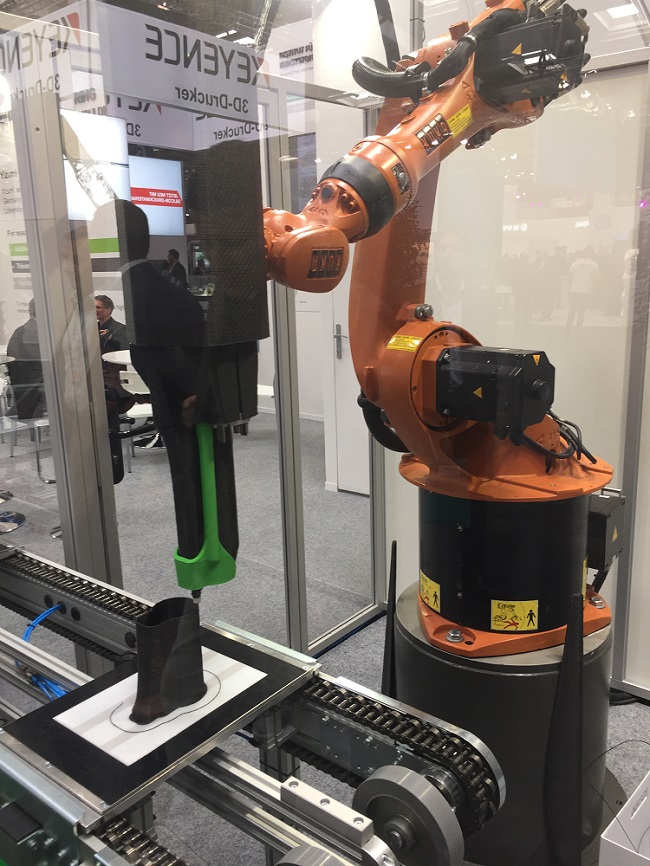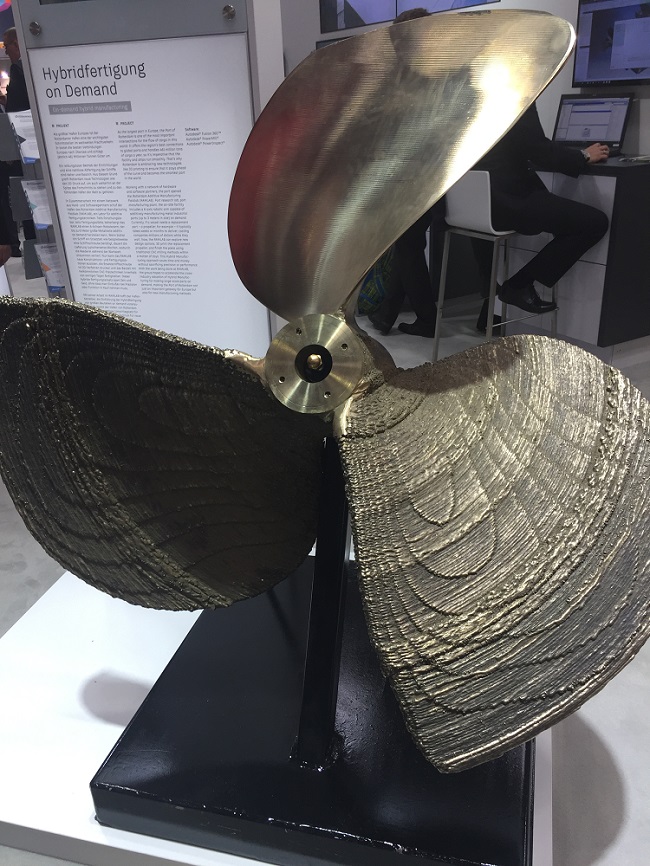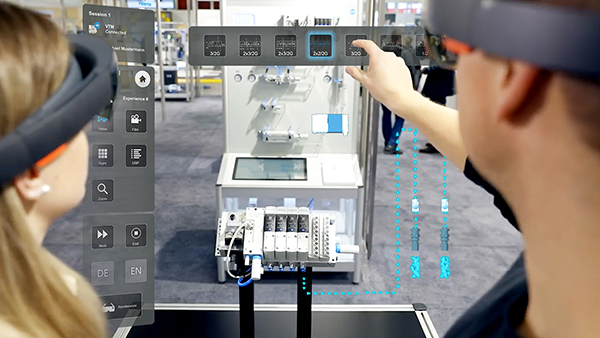By Richard Quinnell, Editor for Special Projects, Technical
As the massive Hannover Messe (Fair) wrapped up for this year, attendees could take away a promising view of industry’s near- and long-term future. Four key trends particularly relevant to the electronics industry were in evidence at the show, some to considerable fanfare and some quietly lurking in the corners. All of them are harbingers of opportunity both for product developers and manufacturers.
3D printing gains industrial strength
One of the trends on prominent display was the rise of industrial-grade 3D printing, or additive manufacturing, as described at the Fair. Once seen as a hobbyist tool for fabricating custom plastic pieces, the technology has since evolved to handle serious industrial applications. Many companies — large and small — had machines on display that worked in plastics, ceramics, metals, and even sand to create solid objects from CAD drawings by building them in layers.
Three types of additive process were on display: extrusion of melted, viscous material such as plastic or Teflon; laser sintering of powdered plastic, ceramic, or metal; and photo-solidification of liquid resins (stereolithography). In support of these techniques, materials vendors offered a wide range of choices. Ultimaker, for instance, supported nylon, ABS, PLA, CPE, polypropylene, polycarbonate, and TUP materials for extrusion, while Protiq offered similar materials for sintering. OR Laser had tool steel, stainless steel, aluminum, titanium, cobalt chrome, and precious metals for sintering.
Highly cost-effective for the creation of prototypes and limited-production items, additive manufacturing technology is also showing signs of becoming practical to high-volume production. HP’s Jet Fusion 3D printers, for instance, include models capable of generating as many as 1,000 units per week from plastic materials. Similarly, the four-laser EOS M 400-4 claims the ability to produce sintered metal products on an industrial scale.
 The IKV additive manufacturing process uses a robotic arm to control the placement of plasticized material, removing the need to perform 3D printing inside an enclosure. Image source: Rich Quinnell.
The IKV additive manufacturing process uses a robotic arm to control the placement of plasticized material, removing the need to perform 3D printing inside an enclosure. Image source: Rich Quinnell.
Vendors are also developing solutions to the size limitations of conventional 3D printing systems. Most systems use an X-Y plotter mechanism to print each layer and a platform able to move vertically to allow the buildup of successive layers atop one another. This approach, however, restricts fabrication to objects that will fit within the printer’s internal workspace, typically 200 to 500 mm on a side.
The Institut fur Kunststoffverarbeitung (IKV) has now attached printheads to robotic arms, which can then control all three axes simultaneously. This robot 3D printing not only allows fabrication of much larger objects, it permits fabrication in any orientation directly on any surface that the arm can reach.
The 3D printing technology is also capable of supplementing traditional fabrication techniques. The sintered-bronze ship’s propeller shown on the next page was constructed using 3D printing, then milled to its final dimension using conventional CNC machining. Also on display at the Fair was the Viridis3D RAM system from Envisiontec that printed sand molds for use in a conventional foundry environment to cast large pieces.
 Additive manufacturing along with conventional machining allowed production of this bronze ship’s propeller in days rather than weeks. Image source: Rich Quinnell.
Additive manufacturing along with conventional machining allowed production of this bronze ship’s propeller in days rather than weeks. Image source: Rich Quinnell.
The number of vendors on hand at the Fair demonstrating their devices, the object size and precision with which these devices could fabricate, and the range of materials available to use are all indicators that additive manufacturing has become a mainstream technology that will play an increasingly important role in industry.
For more on 3D printing, see “3D printing gains industrial momentum . ”
Virtual/augmented technology
A second trend evident at the Fair was a rise in industrial applications for virtual and augmented reality. Virtual reality (VR) creates the digital illusion of a full 3D object or environment, while augmented reality (AR) — sometimes called mixed reality — imposes a digital image on top of a real-world view. Both typically require the user to wear a headset that both tracks head movement and presents the digital image to the viewer.
VR applications tended to target two major application areas. One was collaborative development, in which the VR/AR system could render a 3D representation of a design from CAD drawings and make it available for teams to share a common view. The Visionary Render system from Virtalis, for instance, projects a stereoscopic image on a screen or a monitor so that multiple users can view the same image simultaneously. The other major industrial VR application was for training. Users wearing headsets for immersive VR would interact with virtual objects and environments to learn and practice critical or even dangerous operations without risk to equipment or personnel.
Industrial AR applications on display included data visualization and training apps. In the data visualization applications, users can see and interact with real-time sensor information and status readouts associated with machinery and systems superimposed on their view of the device, eliminating the need for display panels and indicators. In the training applications, AR users could receive instructions without looking away from the machinery being worked on, including guidance as to placement and routing of parts and cables being installed. A similar application allowed the AR system to alert maintenance workers to systems needing repair and highlighting the target devices or components with a digital overlay.
 Industrial AR systems can provide instructional guidance as well as virtual control and display interfaces superimposed on real-world machinery. Image source: Holo-Light.
Industrial AR systems can provide instructional guidance as well as virtual control and display interfaces superimposed on real-world machinery. Image source: Holo-Light.
In addition to the many finished applications available at the show were tools for creating new applications. Augmenta, for instance, offers its SmartPanel tool for creating AR user interfaces such as virtual panels for the control and monitoring of machinery. These virtual panels can be made user-specific so that a machine operator sees a different interface than a maintenance worker and an unauthorized user might see displays but not controls. Upskill’s Skylight platform provided out-of-the box capabilities as well as tools for creating custom AR applications.
For more on virtual/augmented technology, see “Mixed reality: The software is willing, but the hardware is weak . ”
Digital twins
A trend at the Hannover Fair related to VR/AR applications was growing interest in blending the digital and physical worlds using the concept of a digital twin. When developers are designing a new system, they first create CAD and CAE descriptions and then simulate the system’s operation to validate the design. These digital descriptions are then used to guide the design’s physical fabrication. Typically, at that point, the digital and physical worlds separate and can diverge.
The digital twin concept aims to keep the digital CAD and CAE representations linked with the physical object throughout the system’s operational lifetime. The system’s digital twin can evolve out of the design CAD/CAE drawings or, alternatively, can come from a digital representation created from an existing physical object. Either way, instrumentation and measurements made on the physical system get fed into the digital representation so that the digital twin functions in its virtual world in real time the same way that the physical system functions.
 Fully leveraged digital twins can support product design, manufacturing process planning, production, maintenance, and training. Image source: Siemens.
Fully leveraged digital twins can support product design, manufacturing process planning, production, maintenance, and training. Image source: Siemens.
One advantage of the digital twin concept is that developers and maintenance workers can often interact with the digital twin much more readily than its physical counterpart — for safety reasons, to avoid interruption of production workflow, or because the two are not co-located. This allows the developer to try out adjustments and changes to the machinery in the virtual world to validate them before implementation in the physical world.
The data that the physical system feeds back into the digital twin also provides the raw material for predictive maintenance analysis. The twin can store historical information about sensor readings and compare that baseline to current readings to determine if the system is drifting out of tolerances or showing anomalous behaviors. It can then alert system operators to the discrepancy for possible action.
Another use for a digital twin is in maintenance. If something is amiss, such as a signal not reaching its intended destination, workers can use AR to impose a view of the digital twin on top of the actual machinery. Because the digital twin is a complete copy of the real machine, it can determine the signal’s full path from origin to destination and identify the location of each element involved. The AR system can then have the twin highlight what components and cables to inspect for possible failure and guide the maintenance worker step by step to track down the problem.
Yet, though the digital twin concept was on display at the show, and companies such as Siemens had working examples on display, it is still a long way from full implementation. Accurately mirroring the digital and physical worlds will require work to standardize digital representation content and formats as well as development of Industrial IoT sensor systems to gather data from the real-world machines. Still, the approach has compelling advantages and is gathering growing support and interest.
For more on digital twins, see “‘Digital Twins’ enable machine simulation & maintenance, Industry 4.0 ” on our sister site EDN.
Robots and artificial intelligence
Robotic systems were on prominent display at the Fair, especially robots designed to work in close association with humans rather than being isolated inside a safety cage. These collaborative robots — cobots — are designed to operate with limited speed and momentum. They also incorporate sensors that detect if they impact an object unexpectedly so that they can stop moving. These limitations help ensure that the robot’s movements cannot injure a human who accidentally gets in their way.
Unlike the large robotic systems typically used in manufacturing, cobots are not designed for a single purpose. Instead, they have the flexibility of being programmable to take any series of actions within their repertoire. This flexibility makes them ideal as assistants in a wide range of operations, and examples at the show included product assembly, 3D printing, and even the blending, shaking, and pouring of cocktails.
But for these cobots to perform such functions, they must first be programmed to execute a sequence of movements. In many cases, users can program these robots by taking them through the motion sequence and setting waypoints — essentially training them — either by using a joystick to control the device’s movements or by simply grabbing the arm and moving it. While this is a significant improvement over a need to write code, it still requires human effort.
 These two robot arms at the Siemens booth using AI could pick up objects scattered about their workplace and assemble them, as indicated in a CAD drawing, without human training. Image source: Rich Quinnell.
These two robot arms at the Siemens booth using AI could pick up objects scattered about their workplace and assemble them, as indicated in a CAD drawing, without human training. Image source: Rich Quinnell.
In a quiet corner of the Siemens booth, a new way of establishing cobot operation was on display. Siemens was able to blend image recognition (machine vision) with an AI system that could interpret CAD drawings. Using the CAD drawings as the example of a finished assembly, the system could identify individual parts with its machine vision, then pick up and assemble the pieces to match the assembly that the CAD drawings indicated all without requiring human programming. The AI system determined for itself the motion sequence required and then executed them without human involvement.
This technology is still only experimental but is indicative that industrial robots are heading toward autonomous operation. Humans provide the end goals, and the AI-enhanced robot determines the process that it then follows.
For more on robots and artificial intelligence, see “Robots are becoming more helpful, easier to use, and friendlier ” on our sister site EEWeb.
Conclusion
The Hannover Fair is huge, with more than 6,000 exhibitors covering manufacturing from raw materials supply to the packaging of finished goods. These four trends represent only a small part of what is happening as the evolution from today’s factories to what Europe is calling “Industrie 4.0” moves forward. For electronics developers, though, these reflect both emerging design opportunities and critical new production capabilities that will affect them directly.
Check out these other articles in the Industry 4.0 Special Report:
Robots are becoming more helpful, easier to use, and friendlier — At the Hannover Fair this year, industrial robots showed both utility and coworker compatibility.
3D printing gains industrial momentum — Once relegated to prototyping and hobbyist activity, 3D printing is evolving to address industrial requirements.
Mixed reality: The software is willing, but the hardware is weak — While augmented and virtual reality applications for industry are blossoming, headset limitations remain an impediment to widespread adoption.
“Digital Twins” enable machine simulation & maintenance, Industry 4.0 — Marry EDA to the Industrial IoT to birth Digital Twins for system-level maintenance, simulation, and optimization.
Related articles from the ASPENCORE network:
Fear Not the Cobot — Discussing the newest and perhaps most exciting realm of industrial robotics: collaborative robots.
Meet the TI Robotics System Learning Kit — An exciting new university robotics kit and teaching tools from TI will help prepare future engineers for system-level design.
Advertisement
Learn more about Electronic Products Magazine





